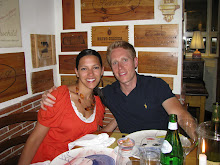
Yes, I'm one of those people who takes pictures of their food when eating out.
"Porchetta" is a little storefront in the East Village that Nicole and I have been wanting to try for a while. I remember doing an internet search one day, figuring there must be some establishment in the U.S. that does a version of this specialty. Lo and behold, in the East Village, where there is such a great variation of niche foodie joints, there is such a place. The first time we made it down there the unthinkable happened--they were "out of pork". Well, not really because they had a rich, salty pork ragu that we tried instead, along with some potatoes and roasted brussels sprouts. But it meant we had to venture back in pursuit of their namesake.
Porchetta is quintessential street food in central Italy. A whole pig or piglet, deboned and organs removed, seasoned with garlic, fennel and a variation of other herbs and spices depending on the purveyor and/or local customs. It is then slow roasted, laid out on a table, sliced crosswise and served warm on simple rolls. You'll usually find the porchetta man selling his lunch meat from a little truck in or just outside a busy piazza. The ears and jowls though are off limits to most tourists, reserved for the town's senior paesans.
To me there are three essential elements of a good slice of porchetta; tender meat with distinct tones of wild fennel and garlic, a layer of very soft palatable fat, and an outside of perfectly crispety crunchy skin. Taking a bite all three textures intermingle, amplified by the occasional munch of coarse salt.
So when Nicole had to go to the city for a wedding dress fitting last Sunday we had an excuse to go back. This time...we were in luck! They had porchetta, succulent hunk upon succulent hunk, lying oozing in the deli case with that distinct cross-hatch patterned, deeply colored and caramelized skin in all its porcine splendor. Considering the dearth we happened upon last time, part of me wanted to snatch a whole slab and be off to the pigeon races.
Porchetta NYC doesn't actually use whole pigs; they take a skin-on pork belly (where slab bacon and pancetta come from) and wrap it around a pork loin. The end result is similar to the original concept, but requires less preparation and cooking. Judging though by the shape of the bone sticking out the side of a piece just out of the oven, I'd say they wrapped the bellies around a pork butt, not a loin. Even better if you're concerned about being short-changed on pork fat.
The menu is small as you can imagine. Porchetta comes on bread or a platter, with sides of things like potatoes, simply cooked beans and greens that change daily. In the time it takes for McDonalds to get your order ready these guys are serving up something speciale. Ok, maybe a little longer than that.
Sometimes I find garlic flavor in roasted meats to be oppressive (garlic burp) if not cooked long enough for it to turn sweet, but theirs was mellow with the fennel pollen really standing out. The meat was chopped and tender, the fat present but not abundant, spiked with squares of skin here and there. Texturally it didn't make for quite the cadence that I've found in Italy, but all the elements were there. The bread was ciabatta rather than the roll you'll traditionally find, and it worked just as well.
As with the last time we were there we ordered a side of roasted potatoes and crispy ends. The potatoes are roasted in the fat and drippings from the meat, along with scraps of pork, the crap cooked out of them to yield salty bits of serious crunchiness...they might be better than bacon, seriously.
We ate almost in silence, save the initial consensus that it was worth the trips. With no condiments (sometimes people put mayo or mustard on) it was still moist enough that no beverage was necessary to wash it down. When we were finished, we weren't stuffed but very content. Yes, it would take a while for our bodies to process that skin and flush out the tablespoons of salt, but we were up and at 'em with little or no tummy rubbing or "whew" ing that accompanies more gluttonous animal fat endeavors.
 If you find yourself in this part of town, check it out. Or put in on your list of ethnic specialties, for which there are so many destinations throughout NYC. The locale is tiny; not big enough to dine out over several courses, just enough space to eat and go, but that's the point.
If you find yourself in this part of town, check it out. Or put in on your list of ethnic specialties, for which there are so many destinations throughout NYC. The locale is tiny; not big enough to dine out over several courses, just enough space to eat and go, but that's the point.Porchetta NYC is located at 110 East 7th Street.







